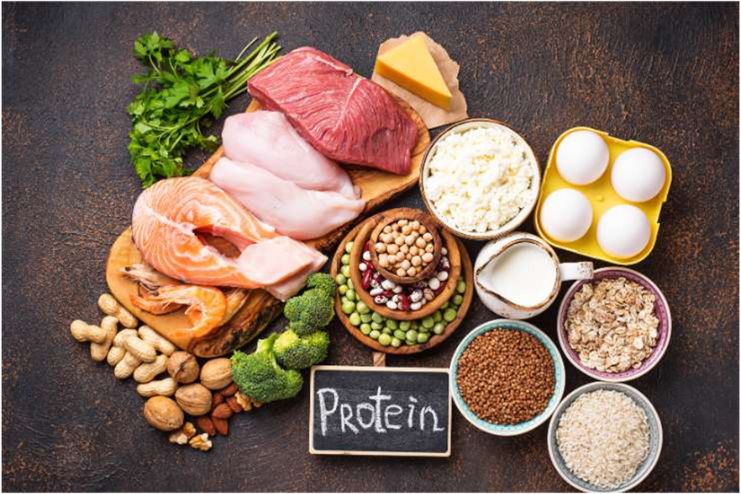Affiliate Disclaimer
Some links in this article are affiliate links. We may earn a small commission if you make a purchase through these links, at no extra cost to you. We only recommend products we find useful to our readersThe building blocks of life, macronutrients—carbohydrates, proteins, and fats—are invisible heroes who work tirelessly in the background to maintain our health and vitality. Macronutrients serve as the structure, the fuel, and the maintenance crew for our intricate body.
Every macronutrient has a specific function: proteins are the builders, repairing and maintaining tissues; lipids, often misinterpreted, are the guardians, storing energy and supporting essential processes; and carbs are the powerhouse, delivering rapid energy.
Comprehending and balancing these macronutrients is not simply a science; it’s an art that dictates how well your body functions. Harmony between them fosters vigor and well-being, but an imbalance can result in weariness, illness, or unintended weight changes. By discovering the ideal balance, you can take control of your health and transform regular meals into the building blocks of a lively, active existence.
Read More: How to Balance Macronutrients for Sustainable Weight Loss
Understanding Macronutrients
Counting your macros has gained popularity as a diet strategy in recent years. Macronutrients are the cornerstones of human health, each serving a distinct purpose in sustaining the complex systems in your body.
“Macros” stand for macronutrients, the nutrients—carbohydrates, fats, and proteins—which your body needs in significant quantities.
Although some people hold strong beliefs about the optimal ratios of macronutrients, the reality is that there is no superior macronutrient. All of them are necessary and carry out tasks critical to general performance and wellness.
In addition to providing us with energy in the form of calories, these nutrients support the upkeep of the body’s numerous systems and structures. Knowing how important macronutrients are to optimal health can help you choose the best balance for you and your body.
Whole grains, leafy greens, and vegetables are good sources of unprocessed, healthful carbs that give the body energy and are a plentiful supply of vitamins and minerals. Additionally, they provide the body with the fiber needed to support a healthy digestive system and regulate blood sugar.
Your body’s proteins are its builders and healers, repairing tissues and muscles and generating hormones and enzymes. Every muscle fiber and hair strand draws its strength from protein. Lean meats, eggs, lentils, and tofu provide protein, which should account for 10–35% of your daily energy consumption.
Despite their unfavorable reputation, fats are essential. They aid in absorbing fat-soluble vitamins (A, D, E, and K), cushion organs, and control body temperature. Nutritious powerhouses are healthy fats found in avocados, nuts, seeds, and fatty fish.
It’s like writing a symphony to balance these macronutrients; each component must work in unison.
Read More: How Travel Impacts Your Gut Health (And What You Can Do About It)
Balancing Carbohydrates

The body uses carbohydrates as its primary energy source, but not all carbohydrates are equal. Each of their three forms—simple, complex, and fiber—has a unique impact on blood sugar levels and general well-being.
Sugars are simple carbohydrates. Simple sugars consist of one or two types of sugar. Fruit and honey contain the simple sugar fructose. You may have sucrose in your cupboard as table sugar, a combination of fructose and glucose. Lactose, present in milk and all dairy products, is likewise composed of two sugar units: galactose and glucose.
Starch is a complex carbohydrate. Several sugar molecules join together to form complex carbohydrates. Vegetables, grains, beans, and peas all naturally contain starch. The complex carbohydrates in starch are broken down into simpler sugar components by your body during digestion.
Another complex carbohydrate is fiber. Naturally, fruits, vegetables, entire grains, cooked dry beans, and peas contain it. The body does not break down fiber. However, some gut bacteria can use it—additionally, fiber aids in passage of waste through the digestive system.
Carbohydrates have gained a very negative reputation in recent years. But for people with diabetes, carbohydrates can be part of a nutritious diet. The secret is to portion and select carbohydrates to maximize their nutritional value while minimizing their effects on blood sugar.
Carbohydrates are needed in the human diet and shouldn’t be entirely eliminated. They power your everyday activities and physical performance.
Your brain and body require carbohydrate for optimal operation. The secret is to portion your serving amounts and choose carbohydrates that are high in nutrients and fiber. In addition to ensuring that you’re eating a good balance of carbohydrates, protein, and veggies, carb counting can assist in managing blood sugar.
Read More: Biohacking for Better Hormonal Balance
Optimizing Protein Intake

People frequently refer to protein as the body’s “building block” for good reason. It is necessary for immune system support, muscle strength, tissue healing, and even synthesizing critical hormones and enzymes.
Proteins contain both essential and non-essential amino acid. The building block of all the proteins in our bodies are amino acids. The essential amino acids must come from the foods we eat because our body cannot produce them on their own. A complete protein is named because it contains every amino acid our body requires for growth and repair.
It is widely acknowledged that, based on several studies and years of data, we cannot achieve the anabolic benefits of resistance exercise if we do not consume enough protein. There is more significant disagreement over the best times to consume protein throughout the day to maximize the benefits of each workout.
Two to three meals a day, each with 25 to 30 g of high-quality protein, are thought to be the best way to stimulate 24-hour muscle protein synthesis (MPS) in healthy individuals. This approximate amount is considered adequate for both younger and healthy older persons.
Most experts in exercise, physiology, and sports nutrition concur that to optimize muscle protein synthesis, people should strive to ingest between 1.6 and 2.2 grams of protein per kilogram daily. It would translate to roughly 109–150 grams of protein per day for a person weighing 150 pounds.
Navigating Healthy Fats

Like protein and carbs, fat is a kind of food that your body requires for energy, vitamin absorption, and protection of your heart and brain. Eating fat has long been associated with increased cholesterol, a wider waist circumference, and other health issues. We now understand, however, that fat is not all the same.
The undesirable things that all fats have been held accountable for—weight gain, clogged arteries, an elevated risk of certain diseases, and so on—are caused by “bad” fats, such as saturated fats and produced trans fats.
However, “healthy” fats like omega-3 fatty acids and unsaturated fats have the opposite effect. Healthy fats are essential for mood management, brain clarity, tiredness prevention, and even weight control.
Fat is very essential for the absorption of fat-soluble vitamins, such as A, D, E, and K. It protects our organs, aids in the formation of cell membranes, makes us feel fuller after eating and insulates our bodies.
The “good fats” are monounsaturated and polyunsaturated because they benefit your heart, cholesterol, and general well-being.
- Reduces the chance of stroke and heart disease.
- Increase healthy HDL cholesterol and decrease bad LDL cholesterol.
- Avoid irregular heartbeats because elevated cholesterol might alter cardiac cells.
- Reduce heart disease-related triglycerides and combat inflammation.
- Reduce blood pressure indirectly by avoiding plaque accumulation in the blood arteries.
Trans fat. Meat and dairy products contain trace levels of naturally occurring trans fats; however, manufactured trans fats are thought to be harmful. It is the worst fat because it reduces good HDL cholesterol while increasing harmful LDL cholesterol. Additionally, inflammation caused by artificial trans fats can lead to insulin resistance and is also associated with heart disease, stroke, and other kind of chronic illnesses.
World Health Organization (WHO) has urged governments worldwide to eliminate artificial trans fats by 2023, and Food and Drug Administration (FDA) has essentially banned their use in commercially produced foods in the United States.
Saturated fat. It’s better to take saturated fat in moderation since it’s not as dangerous as trans fat; too much can affect heart health by raising poor LDL cholesterol. In addition to increasing the size and quantity of triglycerides in your blood, saturated fats may also be detrimental to your arteries. Most nutritionists advise limiting saturated fat to 10% of daily calories, but there’s no need to eliminate it.
Read More: Nutrient Timing: When to Eat What for Optimal Energy Levels
Creating a Balanced Diet

Carbs, proteins, and fats all work harmoniously to produce the best possible health and energy in a balanced diet like a symphony. Finding the ideal balance will keep you full and energized all day long while ensuring your body get the nutrition it needs to function at its peak.
Helpful Advice for a Balanced Plate
- Choose ¼ of your dishes to be whole grains. Whole and intact grains, including whole wheat, barley, wheat berries, quinoa, oats, brown rice, and dishes prepared with them, including whole wheat pasta, are less likely to affect blood sugar and insulin.
- Protein makes up ¼ of your plate. You can pair nutritious and adaptable protein options like nuts, beans, chicken, and fish with veggies on a plate or add them to salads.
- Experts advise moderating the use of healthy plant oils. Avoid partly hydrogenated oils containing harmful trans fats, and go for healthy vegetable oils like peanut, sunflower, maize, canola, olive, and soy.
- Sip tea, coffee, or water. Avoid sugar-filled beverage, consume no more than one or two serving of milk or dairy products daily, and only drink a small glass of juice.
- Continue to be active. Maintaining an active lifestyle is also very crucial for managing weight.
Conclusion
Balanced macronutrients build a lively, healthy life. Carbohydrates energize your day, proteins strengthen and repair your body, and healthy fats protect your heart and mind. Together, they support your body’s growth and healing, laying the groundwork for general well-being.
Adopting a balanced approach to nutrition means making intelligent, nourishing decisions that suit your individual needs; it is not about being flawless. By balancing your consumption of carbohydrates, proteins, and fats, you may unleash the potential for long-lasting energy, better health, and a resilient body.
References
- https://www.healthline.com/nutrition/what-are-macronutrients#what-they-are
- https://www.cdc.gov/diabetes/healthy-eating/choosing-healthy-carbs.html
- https://www.mayoclinic.org/healthy-lifestyle/nutrition-and-healthy-eating/in-depth/carbohydrates/art-20045705
- https://www.downtoearth.org/health/nutrition/fats-carbs-and-protein-balancing-act
- https://www.practo.com/healthfeed/6-ways-to-balancing-carbohydrates-37090/post
- https://www.cdc.gov/diabetes/healthy-eating/carb-counting-manage-blood-sugar.html
- https://examine.com/guides/protein-intake/
- https://www.usada.org/spirit-of-sport/when-consume-protein-muscle-growth/
- https://pmc.ncbi.nlm.nih.gov/articles/PMC5872778/
- https://www.helpguide.org/wellness/nutrition/choosing-healthy-fats
- https://www.healthline.com/health/food-nutrition/healthy-fats-guidelines
- https://nutritionsource.hsph.harvard.edu/2014/06/09/how-to-choose-healthy-fats/
- https://www.nhs.uk/live-well/eat-well/how-to-eat-a-balanced-diet/eating-a-balanced-diet/
- https://nutritionsource.hsph.harvard.edu/healthy-eating-plate/
- https://odphp.health.gov/sites/default/files/2019-10/DGA_Healthy-Eating-Pattern.pdf
- https://www.healthline.com/health/balanced-diet
In this Article




















